Need a flavorful side dish that perfectly complements your favorite meals? Look no further than this water-bathed whole pickled beets recipe!
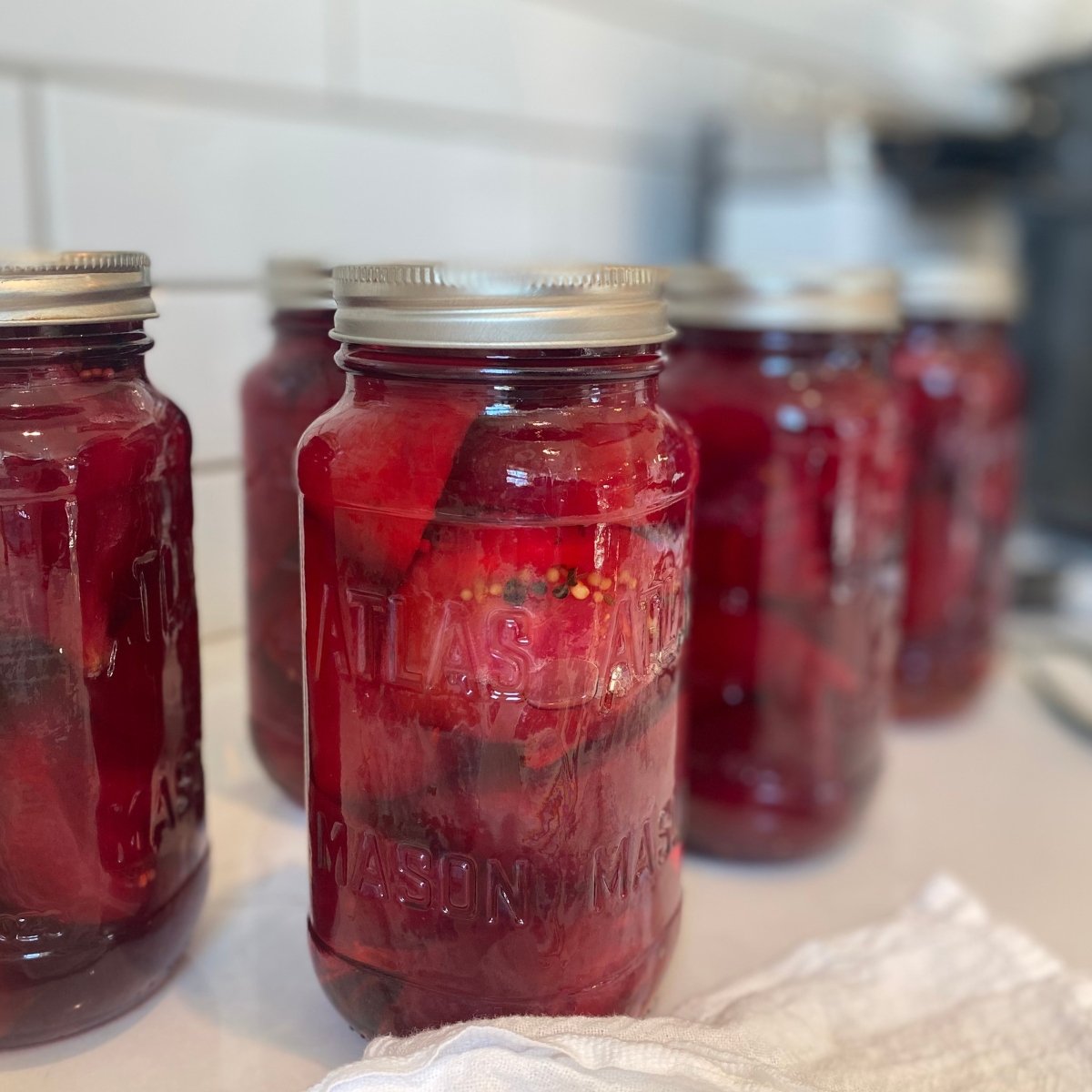
Water-Bathed Whole Pickled Beets Recipe – A Delicious Side Dish for Any Occasion
Made with fresh beets, a tangy pickling brine, and a combination of aromatic spices, these quick pickled beets are sure to become a staple in your kitchen. I’ll guide you through the step-by-step process that I use from the trusted Ball canning recipe, ensuring the best results and maximum flavor retention.
I LOVE pickled beets! they are so good as a side dish, or in a relish tray! These vibrant pickled beets are a crowd-pleaser at potlucks and family gatherings. They’re sure to disappear fast!
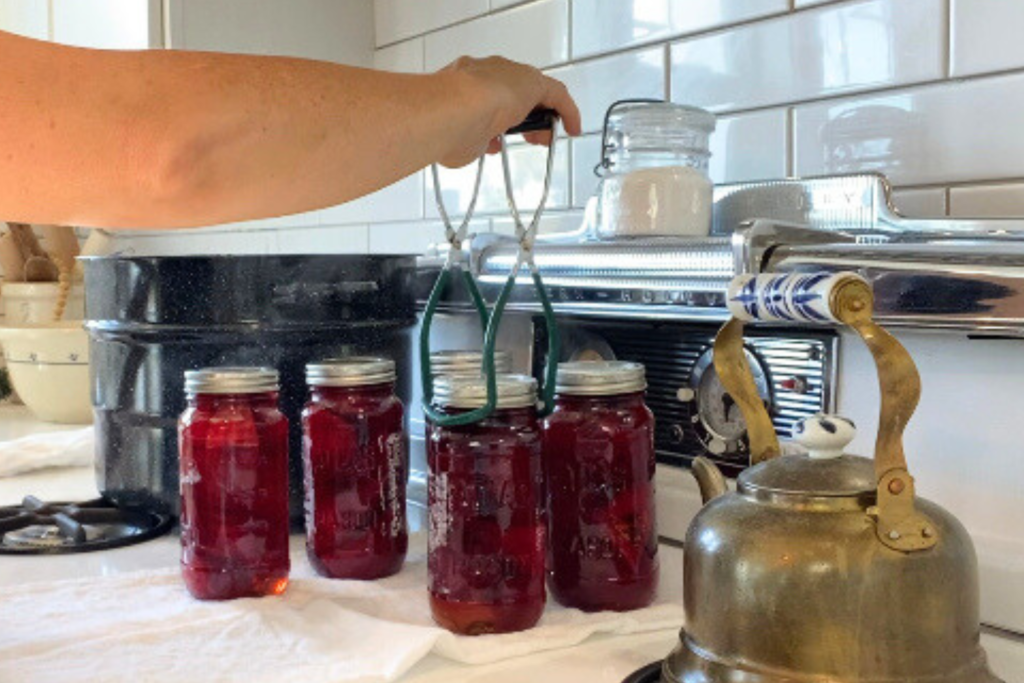
Key Picked Beet Ingredients
Fresh Beets: The star of the show! Choose medium-sized beets, either red or golden, for the best texture and vibrant color. They are the foundation of this sweet and tangy side dish.
5% Acidity Vinegar (White, Apple Cider, Rice Wine): This is crucial for both flavor and food safety. The acidity creates the tangy “pickled” taste and, more importantly, ensures a safe environment for canning by inhibiting bacterial growth. The blend adds a nuanced flavor profile.
Granulated Sugar: Balances the tartness of the vinegar, giving these beets their “sweet” pickled characteristic. It’s essential for that classic sweet and tangy balance.
Canning/Pickling Salt: Different from table salt, this type of salt is free of anti-caking agents and iodine, which can cloud your brine and discolor your beets. It contributes to the brine’s flavor and integrity.
Pickling Spices (Whole Cloves, Mustard Seeds, Cinnamon Sticks): These spices infuse the brine with warmth, subtle heat, and a complex fragrance, taking beets from simple to sooooo good.
Why “Canning or Pickling Salt”?
It’s crucial to use canning salt (also called pickling salt) for home canning. Here’s why:
- No Anti-caking Agents: Regular table salt often contains anti-caking agents that can make your brine cloudy and affect the appearance of your pickled goods.
- No Iodine: Table salt can also contain iodine, which can discolor your pickled vegetables.
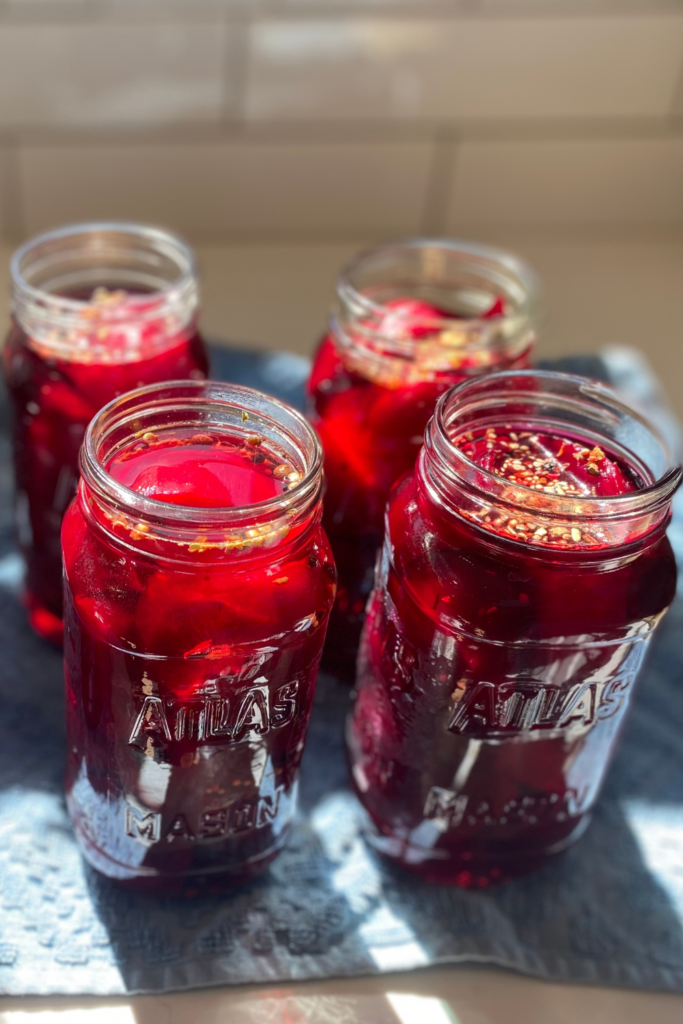
Step-by-Step Guide to Easy Pickled Beets:
Prepare the Beets:
Start by thoroughly washing the beets under cool water to remove any dirt or debris.
Trim off the beet tops, leaving about an inch of the stems intact (optional: save the beet tops for future use).
Boiling beets: In a large pot of salted water, boil the beets until they can be pierced easily with a fork but still offer a little resistance (approximately 25-35 minutes).
Once cooked, drain the beets and immediately submerge them in a bowl of ice-cold water to stop the cooking process.
Once cooled, peel the beets using your hands or a paper towel to gently rub off the skin. The skin should easily slide off.
Prepare the Pickling Brine:
In a medium saucepan, combine the vinegar mixture (equal parts white vinegar, apple cider vinegar, and rice wine vinegar) with water, sugar, and a pinch of salt.
Place the spice bag (containing whole cloves, mustard seeds, and cinnamon sticks) in the brine mixture.
Bring the mixture to a boil over medium-high heat, stirring occasionally until the sugar dissolves completely.
Reduce the heat to low and let the pickling brine simmer for 5 minutes to infuse the flavors.
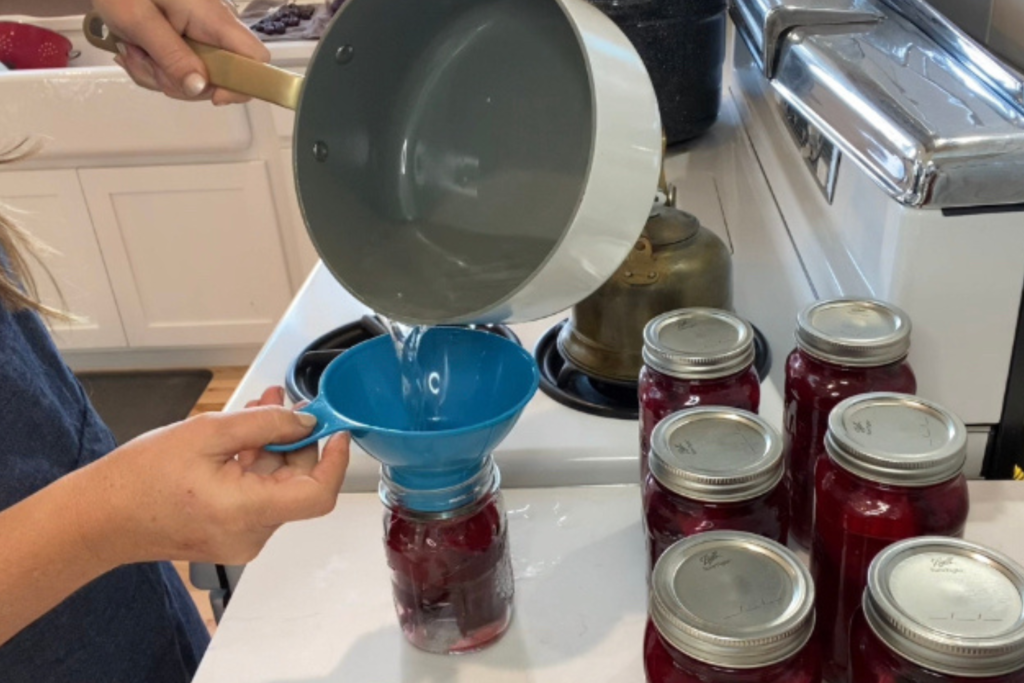
Assemble the Jars:
Prepare your mason jars by washing them in hot, soapy water and rinsing thoroughly.
Place the spice bag at the bottom of each jar, along with a few slices of red onion (if desired).
Pack the peeled beets tightly into the jars, leaving about an inch of headspace at the top.
Pour in the Pickling Brine:
Remove the spice bag from the brine mixture, and carefully pour the hot brine over the beets, ensuring there’s enough brine to cover them completely.
Leave about ½ inch of headspace at the top of each hot jar.
Use a non-metallic utensil to remove any air bubbles by gently pressing down on the beets.
Process the Jars:
Wipe the jar rims with a clean, damp cloth to remove any brine or residue.
Place the lids and screw bands on the jars, tightening them until just fingertip tight.
Prepare a water bath canner, ensuring the water level covers the jars by at least an inch.
Bring the water to a rolling boil and carefully lower the jars into the canner.
Process pint-sized jars for 30 minutes, adjusting the processing time according to your jar sizes and altitude (refer to the National Center for Home Food Preservation for guidance).
After processing, remove the jars from the water bath canner using jar lifters and place them on a towel-lined baking sheet. Allow them to cool undisturbed for 12-24 hours.

Final Steps & Serving
Once cooled, check the jars to ensure they have sealed properly (the lids should be slightly concave and not move when pressed).
Label the jars with the date and contents for future reference.
Store the jars in a cool, dark place for best quality and flavor.
After 1-2 weeks, the pickled beets will be ready to enjoy! They can be served as a side dish, added to salads, or even incorporated into a charcuterie board.
For serving, drizzle the pickled beet juice with a little olive oil and sprinkle with salt and pepper to taste. Garnish with beet tops, if desired.
Optional: Accompany the pickled beets with butter pickles, hard-boiled eggs, or any of your favorite things!
With this water-bathed whole pickled beets recipe, you now have a complete guide to create a delightful and versatile side dish. The combination of fresh beets, a tangy pickling brine, and aromatic spices make for the perfect combination of flavors. Whether you’re a canning enthusiast or just looking to preserve your own beets, this recipe is a great addition to your canning season. Enjoy the convenience of having these delicious pickled beets on hand for future use, and impress your family and friends with your culinary skills. Happy pickling!
You May Also Enjoy These Canning Recipes
Cowboy Candy, Candied Jalapenos Canning Recipe
Applesauce Canning Recipe without sugar!
Please Leave a Review!

Sweet Pickled Beets Canning Recipe
Ingredients
- 3 quarts about 24 medium beets (red and/or golden)
- 1 1/2 cups water
- 1 1/2 teaspoons Salt Canning or Pickling Salt
- 3 1/2 cups 5% acidity vinegar equal parts white vinegar, apple cider vinegar, and rice wine vinegar
- 2 cups granulated sugar white
- 3 tablespoons Ball Pickling Spice or: 10 whole cloves, 2 teaspoons whole mustard seeds 3 Cinnamon sticks Spice bag (for cloves, mustard seeds, and cinnamon sticks)
Instructions
Prepare the Beets:
- Start by thoroughly washing the beets under cool water to remove any dirt or debris.
- Trim off the beet tops, leaving about an inch of the stems intact. (Optional: save the beet tops for future use).
- In a large pot of water, boil the beets until they can be pierced easily with a fork but still offer a little resistance (approximately 25-35 minutes). You can add a pinch of salt to the boiling water for flavor, but this salt is not for preservation.
- Once cooked, drain the beets and immediately submerge them in a bowl of ice-cold water to stop the cooking process.
- Once cooled, peel the beets using your hands or a paper towel to gently rub off the skin. The skin should easily slide off.
Prepare the Pickling Brine:
- In a medium saucepan, combine the vinegar mixture (equal parts white vinegar, apple cider vinegar, and rice wine vinegar) with water, sugar, and 1 1/2 teaspoons of canning or pickling salt.
- Place the spice bag (containing the whole cloves, mustard seeds, and cinnamon sticks) in the brine mixture.
- Bring the mixture to a boil over medium-high heat, stirring occasionally until the sugar dissolves completely.
- Reduce the1 heat to low and let the pickling brine simmer for 5 minutes to infuse the flavors.
Assemble the Jars:
- Prepare your mason jars by washing them thoroughly in hot, soapy water and rinsing well. For best results and to prevent thermal shock, keep the jars hot until ready to fill (e.g., in a hot water bath, a warm oven, or a clean dishwasher).
- Place the spice bag (containing your chosen spices) at the bottom of each jar, along with a few slices of red onion (if desired).
- Pack the peeled beets tightly into the jars, leaving about an inch of headspace at the top.
Pour in the Pickling Brine:
- Remove the spice bag from the brine mixture.
- Carefully pour the hot brine over the beets, ensuring there’s enough brine to cover them completely.
- Leave about ½ inch of headspace at the top of each hot jar.
- Use a non-metallic utensil (like a plastic spatula or chopstick) to remove any trapped air bubbles by gently pressing down on the beets and running the utensil along the inside of the jar.
Process the Jars:
- Wipe the jar rims with a clean, damp cloth to remove any brine or residue. This helps ensure a proper seal.
- Place the lids and screw bands on the jars, tightening them until just fingertip tight.
- Prepare a water bath canner by placing a rack at the bottom. Fill the canner with water, ensuring the water level will cover the jars by at least an inch once they are loaded. Bring the water to a rolling boil.
- Carefully lower the jars into the canner using jar lifters. Ensure the water level covers the jars by at least an inch during the entire processing time. Add more boiling water if needed.
- Process pint-sized jars for 30 minutes at a rolling boil. Adjust the processing time according to your jar sizes and altitude (refer to the National Center for Home Food Preservation for specific guidance).
- After processing, turn off the heat and let the jars remain in the canner for 5 minutes before removing them. This helps prevent siphoning (liquid loss from the jars).
- Remove the jars from the water bath canner using jar lifters and place them upright on a towel-lined baking sheet in a draft-free location. Allow them to cool undisturbed for 12-24 hours.
Final Steps & Serving:
- Once completely cooled, check the jars to ensure they have sealed properly (the lids should be slightly concave and not move when pressed down). If any jar hasn’t sealed, refrigerate and consume within a few days.
- Label the sealed jars with the date and contents for future reference.
- Store the jars in a cool, dark place for best quality and flavor.
- After 1-2 weeks, the pickled beets will be ready to enjoy! This allows the flavors to fully meld.
- They can be served as a side dish, added to salads, or even incorporated into a charcuterie board.
- For serving, you can drizzle the pickled beet juice with a little olive oil and sprinkle with salt and pepper to taste.
Notes
- Altitude Adjustments are Crucial: If you live above 1,000 feet in elevation, you must increase your processing time. Refer to the National Center for Home Food Preservation (NCHFP) website or a current Ball Blue Book for precise altitude adjustments. This is essential for safe canning.
- Use Canning Salt Only: Always use canning or pickling salt as it’s free of anti-caking agents and iodine that can cloud your brine and discolor your beets. Regular table salt is not recommended.
- Don’t Rush the Cooling: Allow jars to cool undisturbed for the full 12-24 hours. Don’t retighten bands during cooling, as this can interfere with the seal.
- Check Seals Properly: After cooling, confirm all jars have sealed by pressing on the center of the lid. It should be concave and not flex. If a lid doesn’t seal, refrigerate that jar and consume its contents within a few days.
- Patience for Flavor: While safe to eat once sealed, these pickled beets develop their best flavor after 1 to 2 weeks in storage, allowing the spices and brine to fully permeate the beets.
- Storage: Store sealed jars in a cool, dark, and dry place. Properly canned beets can last for up to a year, though quality is best within 6-9 months.
- Spice Variation: Feel free to adjust the amount of pickling spice or individual spices to suit your preference. However, do not alter the vinegar, water, or sugar ratios, as these are critical for safe preservation.

About Juliea
Juliea Huffaker is the creator of Farmhouse Harvest, and dedicated to teaching from-scratch cooking, sourdough baking, gardening, and food preservation. With over 25 years of hands-on experience she has preserved hundreds of jars of produce, mastered the art of meats and sourdough baking, and nurtured a thriving organic garden. Her recipes and articles have been featured across the web. And she’s passionate about inspiring others to embrace a simpler, self-sufficient life style.



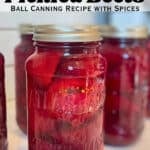
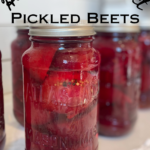

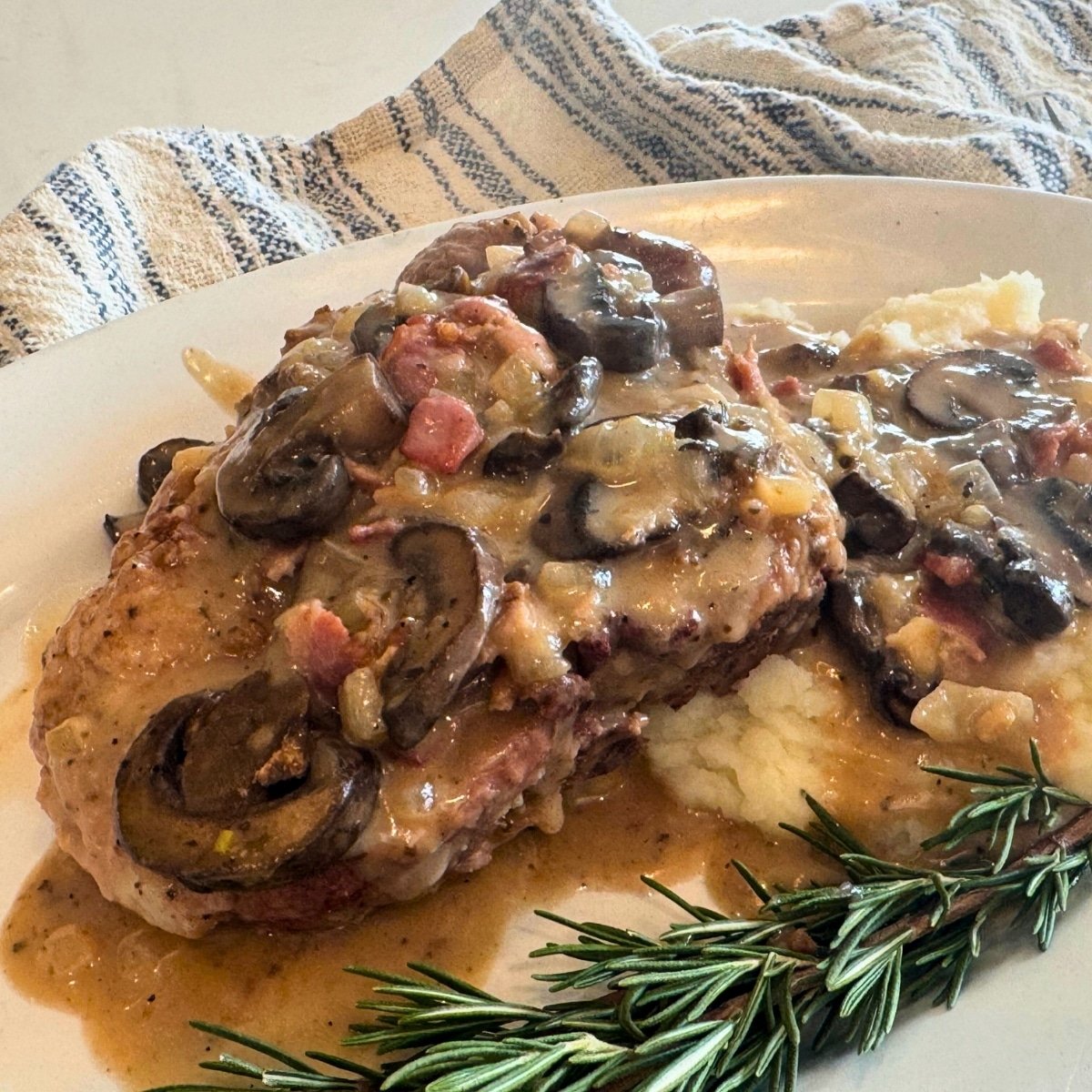



5 comments
McKenna
I love beets, but I have never thought to pickle them before. Oh, I bet they are tasty. Thank you for sharing the step-by-step directions!
juliea
Hi McKenna! Aren’t beets wonderful?! I hope you give pickled beets a try… It’s the best way to preserve them around here (root cellaring them would also be wonderful, if you had a root cellar.)
Renee Schiepers
Never heard of pickled beets, sounds delicious!
Dusty
Yum! These look delicious. Saving this for later to make! Thanks for sharing 🙂
Alicia
I love pickled beets in my salad! I didn’t get any planted in the spring but I will be planting fall beets soon. I bookmarked this post to come back to when I’m ready to pickle.